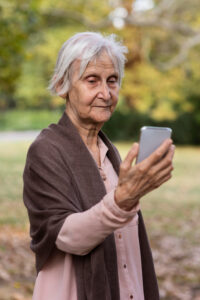Navigating Long-Distance Caregiving: Challenges and Solutions
This type of caregiving is more common now than ever. Families aren’t staying in one place. Jobs pull people to different cities. Sometimes, life just takes us in unexpected directions. But ageing parents, ailing relatives, or loved ones with special needs still require care, no matter where you are.
That distance makes things harder. You can’t pop in to check on someone. You can’t swing by the pharmacy or help with groceries. Instead, you’re trying to coordinate everything through phone calls, emails, or apps. And when something goes wrong—a fall, an illness, a missed appointment—you feel helpless.
It’s not just the practical stuff, either. The emotional weight can be crushing. Guilt sneaks in. You feel torn between your own life and the care someone else needs. The constant worry doesn’t let up. And still, life keeps moving. Bills need paying. Kids need attention. Work doesn’t stop.
This is the reality for many caregivers today. It’s tough. It’s messy. But with the right mindset and tools, it can be managed. Let’s break down the biggest obstacles you’ll likely face—and what makes them so tricky.
Common Challenges in Long-Distance Caregiving
So, how to help elderly parents from a distance? Caring for someone from a distance sounds doable—until you realize yourself in a situation where you are actually in response to someone’s life. And you’re from miles away. Your actions are often based on patchy information. It’s frustrating. It’s exhausting. And it comes with specific, hard-to-ignore challenges.
1. You Can’t See What’s Really Happening
A quick phone call rarely paints the full picture. Your loved one might say they’re fine, but the reality could be very different. They might be missing meals, skipping medications, or letting bills pile up.
Even well-meaning family members or neighbors might downplay issues. No one wants to admit that things are falling apart. And as a caregiver, you’re left guessing what’s true and what’s not.
Why it’s hard: You miss subtle signs—like changes in their speech, mobility, or even mood—that only in-person visits would reveal. Those missed details can have serious consequences.
What to do:
- Schedule video calls, not just phone calls. Pay attention to how they look—are they dressed properly? Is their house in the background tidy or chaotic?
- Ask someone local to do a visual check weekly. It could be a friend, neighbor, or even a delivery person.
- Consider setting up cameras in common areas (with consent) for safety checks. It might feel intrusive, but it’s one way to catch early warning signs.
2. Managing Medical Care Is a Maze
Doctors assume someone will be there to help—whether it’s managing medications, attending appointments, or understanding treatment plans. But if you’re not local, that responsibility often falls into a black hole.
Prescriptions might get mixed up. Appointments might be missed. And you can’t jump in to clarify things in real time.
Why it’s hard: Medical systems aren’t built for long-distance caregivers. Information is scattered, and healthcare providers rarely loop in remote family members.
What to do:
- Centralize medical information using a shared app like CareClinic or MyChart. These apps store medication lists, appointment schedules, and doctors’ notes in one place.
- Build a relationship with the primary doctor. Let them know you’re the point of contact, and ask to be included in important discussions—even if it’s over the phone.
- Hire a local patient advocate. These professionals can attend appointments and relay accurate information back to you.
3. Emergencies Feel Like a Crisis Every Time
Emergencies are the worst-case scenario for long-distance caregivers. A fall, a broken appliance, or a health scare can turn your day upside down.
But you’re not just managing the emergency—you’re also trying to find someone local to step in. And that’s where things get complicated.
Why it’s hard: You often have to rely on strangers or services you don’t fully trust to handle critical situations.
What to do:
- Set up a local safety network. This includes neighbors, friends, or even local businesses. For example, the pharmacy delivery person can alert you if your loved one isn’t answering the door.
- Create an emergency checklist. Include contact numbers for local services, like handymen, urgent care clinics, and transportation services. Share it with everyone in the network.
- Use medical alert systems that notify both emergency responders and you in case of a fall or health crisis.
4. Everyday Tasks Become Overwhelming
Daily life doesn’t stop just because you’re far away. Groceries need buying. Bills need paying. Prescriptions need refilling.
These everyday tasks can pile up quickly, especially if your loved one isn’t able to keep up. And suddenly, you’re in charge of micromanaging their entire life from afar.
Why it’s hard: You’re trying to handle logistics remotely, often without knowing what’s really needed.
What to do:
- Automate what you can. Set up auto-pay for bills. Arrange for grocery delivery services like Instacart or Walmart+.
- Hire local help. A home care aide can assist with errands, while a geriatric care manager can oversee larger responsibilities.
- Ask about community resources. Many senior centers or local churches have volunteer programs that assist with errands and transportation.
5. Communication Breakdowns Happen Constantly
Keeping everyone on the same page is a challenge. Doctors, family members, and caregivers all have different pieces of the puzzle—and no one has the full picture.
Miscommunication leads to missed appointments, incorrect medication doses, or conflicting care plans.
Why it’s hard: Everyone is working in silos, and you’re often the last to know.
What to do:
- Use a shared communication app like Lotsa Helping Hands to keep track of tasks and updates.
- Appoint a “point person” for each task. For example, one sibling handles medical appointments while another takes care of finances.
- Schedule regular family meetings. Even a 15-minute call once a week can prevent miscommunication.
Okay. Now, we all see that being a long-distance caregiver is tough. Are there tools that help to ease our task? Of course there is! So, let’s explore them below.
How Technology Can Help Long-Distance Caregivers
Living far from someone who needs your help can really make you feel disconnected. You’re curious about whether they’re eating well, keeping up with their appointments, or if they might be slipping on their medications. That constant worry is always hanging around because you just can’t be sure.
Being there in person is irreplaceable, but technology really helps us stay connected like never before.
Health Monitoring Tools Keep You Updated Without Nagging
You don’t want to call every day to ask how you are feeling. But you also don’t want to wait until something serious happens to find out something’s wrong.
Many caregivers thus turn to medical alert devices or health trackers. They can track heart rate, activity level, even falls and notify your phone. You will receive some peace of mind without always checking in.
Start small if your privacy concerns are serious. Even a basic step counter can indicate whether your loved one is moving as usual or whether they have been more inactive than normal. It’s a peaceful approach to spot changes that might call for more investigation.
Keeping Track of Medications Without the Guesswork
One missed dose might not be a big deal. But when medications pile up, managing them from a distance can feel overwhelming.
You could call every morning to remind them to take their pills. Or you could use smart pill dispensers that handle it for you. Some will only open at the right time and even send alerts if a dose is skipped.
Not into gadgets? Set up a shared calendar with medication reminders. It’s a simple way to stay in sync without hovering.
The goal isn’t perfection. It’s to make things easier for both of you.
Video Calls Make It Easier to Spot Changes
Phone calls are fine, but they only tell part of the story. Video calls let you see what’s really going on.
You might notice that the house is messier than usual. Or that they look more tired than they’re letting on. These little things are easy to miss when you’re just hearing their voice.
Keep the calls casual. You don’t need a formal check-in every time. Sometimes a quick chat over dinner or a spontaneous hello is enough to keep that connection strong—and to notice when something feels off.
Smart Home Devices Handle Everyday Safety
When you’re not around, small risks can turn into big problems. Forgetting to turn off the stove. Leaving the door unlocked. Falling in the bathroom.
Devices like motion sensors or smart plugs can help reduce those risks. Some will send alerts if they detect unusual behavior, like no movement for a while. Others can shut off appliances automatically.
Virtual Counseling: A Lifeline for Both of You
Long-distance caregiving is demanding. When you feel like your efforts are constantly falling short, it can be quite demoralizing.
You can work through that stress by consulting a counselor. Thanks to virtual counseling services, you can easily arrange sessions at your convenience, without having to worry about getting to a physical location.
Your loved one might benefit from it, too. Aging can be lonely, and it’s not always easy to open up to family. Sometimes, it’s easier to talk to someone neutral.
Building a Local Support Network for Long-Distance Caregiving
What if your circumstances demand immediate assistance? What will you do? To whom will you call? Have you established these vital connections? And how to build them effectively? Discover below.
Start with People They Already Know
You don’t need to start from scratch. Think about the people who are already part of their daily life. Maybe it’s a neighbor who brings in their mail or a friend who stops by for coffee. These familiar faces can be your starting point.
Ask them whether they would be eager to assist with little chores or routinely check in. You’re just asking for a little additional attentiveness; don’t make it sound like a formal position. People are often willing to help, but they are not aware they are required until you ask.
Tip: Create a shared list of contacts. Include neighbors, friends, nearby relatives, and service providers like pharmacists or home care aides. Make sure everyone has it.
Tap Into Local Services
Many localities provide low-cost or free programs for elderly citizens. These programs cover everything from transportation to doctor visits to meal delivery. You would be astonished by the abundance of tools available; all you need to know is where to look.
Check with local senior centers, religious organizations, or volunteer groups. Many of them have programs specifically designed to support aging adults who live alone. Some even offer regular check-ins or social visits to reduce isolation.
Also, don’t forget pharmacies and grocery stores. Many now offer delivery services, which can take one more task off your plate.
Build a Relationship with a Neighbor or Friend
Sometimes, you need someone who can pop over at a moment’s notice. Maybe it’s to check why the phone line isn’t working. Or to make sure the front door is locked.
Finding that “go-to” person is invaluable. It could be a neighbor, a member of their church, or even someone from their bridge club. But it’s important to build that relationship over time. People are more likely to help if they feel connected to both you and your loved one.
A simple way to start? Send a handwritten thank-you note after they’ve helped with something. It’s a small gesture, but it makes a big impact.
Involve Professionals When Needed
There are times when tasks are too large for a neighbor or friend to handle. That’s when it helps to hire professionals.
If your loved one requires specialized end-of-life care, consider hiring a geriatric care manager to oversee daily needs or coordinating with a hospice Attending Physician. These professionals can handle medical decisions and symptom management and ensure that your loved one is as comfortable as possible.
If that feels too formal, look for local home care agencies that offer part-time assistance. Sometimes, just having someone stop by a few times a week to help with meals or chores can make a huge difference.
Don’t Overlook Emotional Support
It’s easy to focus on logistics—who’s picking up the groceries, who’s driving to the doctor—but caregiving is about more than errands. Your loved one needs emotional support, too.
Loneliness can creep in fast, especially if they’ve lost friends or family nearby. That’s why finding local social groups is just as important as arranging practical help. Look for clubs, church groups, or hobby meetups. Even a weekly book club can provide a sense of connection.
Your local network shouldn’t just handle tasks. It should help your loved one feel part of the community.
Keep Communication Open
Once your network is in place, keep everyone in the loop. Regular updates help avoid misunderstandings and make things run smoothly.
You don’t need to overdo it—a quick group text or email works. Share important updates, like doctor visits or changes in medication. And be sure to check in to see how everyone is feeling. Caregiving can be emotionally draining for everyone involved.
Tip: Use an app like Lotsa Helping Hands to coordinate schedules and share updates in one place. It saves time and avoids missed messages.
Self-Care and Emotional Support for Long-Distance Caregivers
If you’re not okay, the care you give won’t be either. That’s the reality. Long-distance caregiving isn’t just about logistics—it’s emotionally exhausting. So, you need a plan for yourself, not just for the person you’re caring for.
Don’t Carry Guilt Around
Caregiving guilt creeps in quietly. It makes you question if you’re doing enough. It makes you feel bad for not being there every minute.
But here’s the truth: guilt doesn’t solve problems. It only drains your energy. Instead of beating yourself up, remind yourself that you’re doing what you can, given the distance and your own life.
Drop the guilt, and you’ll feel lighter. You’ll be a better caregiver because of it.
Keep Real Conversations Going
It’s easy to fall into task-mode. Did you eat? Did you take your meds? Did you see the doctor? But these check-ins don’t build emotional connection.
Make time for real conversations. Call just to chat, share a funny story, or ask about their favorite memories. Connection matters more than constant updates. It keeps them—and you—from feeling alone.
Write Things Down Before You Overthink Them
The mental load of caregiving is huge. Doctor appointments. Medications. Bills. You’ll drive yourself crazy trying to remember it all.
A caregiver planner isn’t a luxury—it’s survival. Use it to track what needs to be done and who’s handling it. This way, you’re not mentally juggling everything 24/7.
Take Care of Your Own Headspace
Caregivers get emotionally drained fast. You carry worry, guilt, frustration—all of it.
Find emotional support for yourself, too. A support group. A counselor. Even a friend who gets it. You’re human. You need to vent.
It’s not a weakness. It’s what keeps you strong enough to care.






Post Comments